By Sydney Millerd
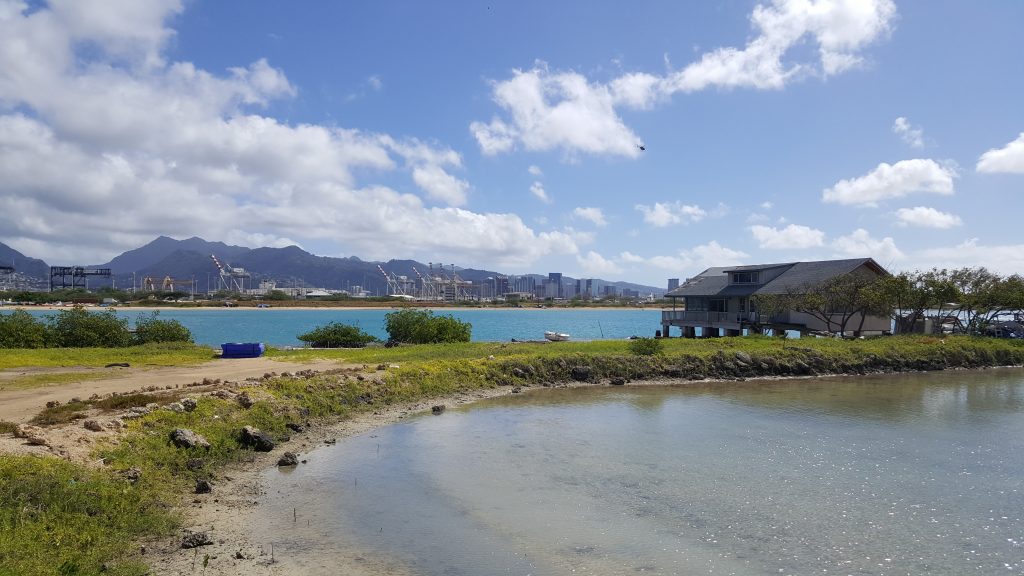
Abstract
Mokauea Island was once part of a productive food system in the waters of Keʻehi, which held more than 40 ancient Hawaiian loko iʻa (Hawaiian fishponds). However, as a result of dredging and westernized “development,” the food system including its loko iʻa were destroyed. Today, a non-traditional fishpond remains on the east side of Mokauea Island. However, its poor design resulted in poor circulation and was not suitable for fish production. Therefore, in an effort to restore the pond, oyster cultivation is being considered. With the advice of an oyster-expert, Pacific oysters are particularly being considered since water temperature and salinity are critical factors that contribute to the success of oysters. A statistical analysis of one-year bottom and surface water temperatures and salinity data from May 22, 2019 to May 22, 2020 is performed to explore the suitability of Mokauea loko iʻa in terms of its water temperatures and salinity levels.
Overview
Known as Oʻahu’s last Hawaiian fishing village, Mokauea Island is a 13-acre island that sits in the waters of Keʻehi located off the coast of Oʻahu’s Mauliola (Sand Island). On the southeast end of the island sit a loko iʻa (Hawaiian fishpond). This fishpond, and roughly 40 other ponds in the Keʻehi region, were responsible for producing hundreds-of-thousands of pounds of fish each year for the Native Hawaiians (Friedheim, 2017). Unfortunately, due to dredging of Keʻehi, these loko iʻa were destroyed. The destruction of these productive fishponds and marine ecosystems also destroyed the livelihoods of the Native Hawaiians who called Mokauea home as their culture and the land that their families held for generations were stripped away. Today, only three families remain on Mokauea. The island’s loko iʻa is the last fishpond in the area, however, its current physical state and water quality are not suitable for fish production.
Although Mokauea Island has gone through many trials and tribulations, the island and its rich history, culture, and science live on today via “Hoʻōla Mokauea,” an educational program lead by Mauliola Keʻehi that has helped to return life to the island for the past ten years. However, a goal to further this community engagement and empowerment is to restore the island’s fishpond which will also serve as a food source in Hawaiʻi’s efforts to achieve food security. Therefore, to restore this fishpond, the use of oysters is being considered. With the advisement of Dr. Maria Haws of the Pacific Aquaculture and Coastal Resources Center (PACRC) at the University of Hawaiʻi at Hilo, adult Pacific oysters (Crassostrea gigas) will likely be the species that is used to restore the loko iʻa as they are a rather tolerant species (personal communication, March 23, 2020).
As explained by Dr. Haws, critical factors that impact the success of oysters in a body of water include temperature and salinity (personal communication, March 23, 2020). Therefore, in this paper, we explore the suitability of Mokauea loko iʻa water temperatures and salinity levels to support Pacific oysters. Before delving into the analysis, we look back on the history of Mokauea Island and its loko iʻa, the use of oysters for water restoration, and the significance of temperature and salinity for water restoration. Next, water temperatures (bottom and surface) and salinity (raw) data collected over the past year (May 22, 2019 to May 22, 2020) in Mokauea loko iʻa is presented and analyzed. Finally, we summarize the findings, challenges, and further work that need to be done.
Background
History of Mokauea Island & Loko iʻa
Mokauea Island was once a thriving fishing village that was entirely self-sufficient with a functional fishpond, plenty of vegetable and medicinal plants and seaweed (limu), and a healthy supply of reef fish surrounding the island (Mokauea Fishermen’s Association [MFA], n.d.). The island’s fellow 40-some fishponds in the waters of Keʻehi were also very productive, and together, the area was a food system that was able to produce 560,000 pounds of fish annually (Friedheim, 2017). In addition, Keʻehi was a naturally shallow stretch that allowed people to walk the area to collect limu and other types of seafood for consumption, further showcasing the area’s productivity (Friedheim, 2017). However, this thriving food system and self-sufficient community would come to an end.
The destruction of Mokauea Island and Keʻehi began with the dredging of the body of water to make a runway for seaplanes in 1941 following the bombing of Pearl Harbor (“Volunteers help to save Hawaiian fishing village,” 2009). All Mokauea residents, whose families have lived on the island for generations, were also evicted from their island by the US military as America joined World War II so that a military outpost could be installed on the island and to deepen the harbor for Navy ships (Kandell, 2012). The planned military outpost was never built, however, due to the damage, many families never returned to the island following the war (Kandell, 2012). Unfortunately, this was not the end of Mokauea’s challenges as the island was to face additional trials and tribulations in the years to come.
In 1972, the State of Hawaiʻi attempted to evict Mokauea’s remaining 17 families to build an airport runway extension citing that they could do so because the island lacked any cultural significance and that the families living on the island were “squatters” (MFA, 2018). The homes of five families on the island were also burned down by the State which caused a public outcry (MFA, 2018). The State did eventually stop burning down homes once the Mokauea community and their allies threatened to sue the state for arson (MFA, 2018). Following these events, in 1978, the State negotiated a 65-year lease with Mokauea residents agreeing to let them live on the island (MFA, 2018). However, today, only three families remain on Mokauea Island (MFA, 2018).
As a result of damage done to Mokauea Island and Keʻehi, the area once plentiful in fishponds is now bare. Today, only a man-made, 50 by 100-yard fishpond remains on the east end of Mokauea Island. The pond was constructed by the US Navy in efforts to create an education program for local students to learn about traditional fishing practices following the 65-year lease agreement (Kakesako, 2011). However, the pond was not properly built causing circulation issues that contribute to its current shallow depth and poor water quality. Unlike other loko iʻa, Mokauea loko iʻa has only one ʻauwai (canal) accessible for ocean water to flow in and out. Thus, in present-day, Mokauea loko iʻa is unsuitable for raising fish.
Use of Oysters for Water Restoration
Oysters are known as filter feeders that are capable of removing excess phytoplankton, zooplankton, nutrients, and sediments from a body of water (USF Water Institute, n.d.). Adult oysters can filter between 30 to 60 gallons of water per day (USF Water Institute, n.d.). As oysters are effective and efficient in doing so, the use of oysters for water restoration has been used around the world. Locally, PACRC has placed Pacific oysters, Hawaiian oysters (Dendostrea sandvicensis), and black-lip pearl oysters (Pinctada margaritifera) in several bodies of water in Hawaiʻi including Kāneʻohe Bay, Pearl Harbor, Māʻalaea Bay, and Hilo Bay.
Significance of Temperature & Salinity for Water Restoration Via Oysters
With the advice of PACRC oyster-expert Dr. Haws, Pacific oysters will likely be the oyster species selected for water restoration in Mokauea loko iʻa. She explained that temperature and salinity are some of the most critical parameters that can impact oyster success (personal communication, March 23, 2020). Pacific oysters have a broad temperature tolerance of -1.8 to 35 °C (Food and Agriculture Organization of the United Nations [FAO], n.d.). Pacific oyster gametogenesis begins around 10 °C and spawning occurs above 20 °C (FAO, n.d.). Pacific oysters experience rapid growth at temperatures between 15 to 25 °C (FAO, n.d.). As for salinity, their optimal range is 20 to 25 PSU, however, they are capable of surviving at salinity levels below 20 PSU and above 25 PSU, up to 35 PSU (FAO, n.d.).
Methods
Mokauea loko iʻa’s bottom and surface water temperatures and salinity levels from May 22, 2019 to May 22, 2020 have been collected via the University of Hawaii’s School of Ocean and Earth Science and Technology’s (SOEST) SMART Coastlines Monitoring System (Glazer, n.d.). The bottom and surface water temperature instrument is located in the center of the pond and measurements are collected with burst readings every minute. The salinity instrument is located near the mākāhā, the sluice gate that regulates fish flow in and out of the pond placed in the ʻauwai, and measurements are collected several times per minute. Using the programming language R, the year’s worth of raw data was analyzed to understand if yearly temperatures & salinity levels in Moakeua loko iʻa are suitable for Pacific oysters.
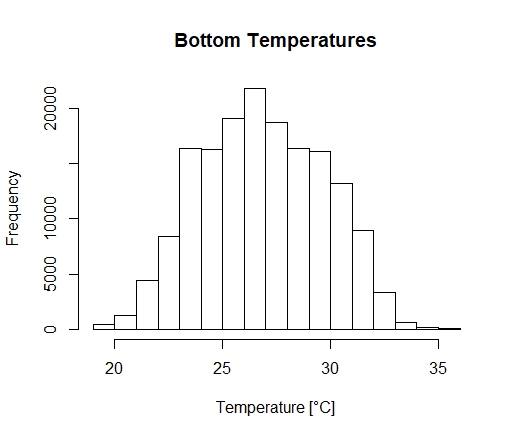
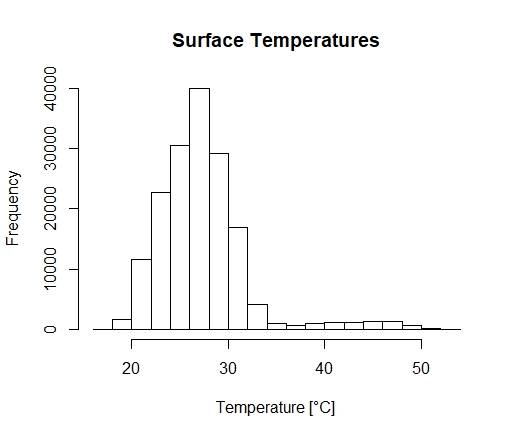
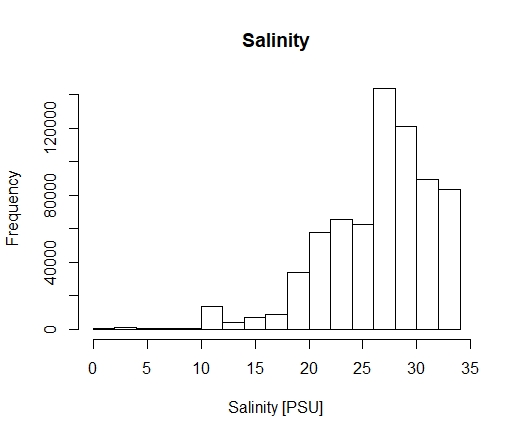
Data
During the observation period, 165,365 bottom temperature observations were collected. Temperatures ranged from 19.271 to 35.350 °C with an average of 26.846 °C and a median of 26.749 °C. As for surface temperatures, 165,365 observations show the temperature ranged from 17.913 to 53.234 °C with an average of 27.261 °C and a median of 26.728 °C. Finally, 695,901 salinity observations were collected. Salinity ranged from 0.065 to 33.574 PSU with an average of 26.328 PSU and a median of 27.225 PSU. Figure 1. Moakuea loko iʻa histograms. Histograms created in R Studio to display the frequency of Mokauea loko iʻa’s raw data bottom temperatures, surface temperatures, and salinity levels from May 22, 2019 to May 22, 2019.



Analysis
Given that Pacific oysters have a broad temperature tolerance of -1.8 to 35 °C, the data shows for the majority of the year, the oysters will be able to survive in Mokauea loko iʻa since both bottom and surface water temperatures were all between -1.8 to 35 °C for 95.335% of May 22, 2019 to May 22, 2020. Oysters will also be able to go through gametogenesis as all loko iʻa temperatures were above the necessary 10 °C. As for spawning which occurs above 20 °C, Mokauea loko iʻa year around temperatures allow for the event to occur the majority of the time as approximately 99% of the bottom and surface water temperatures are above 20 °C. Additionally, rapid growth of Pacific oysters which occurs between 15 to 25 °C is also possible in Mokauea loko iʻa. However, this is not as probable as only 28.458% and 29.883% of bottom and surface water temperatures, respectively, are between the 15 to 25 °C range.
As for the suitability of Mokauea loko iʻa’s salinity, 100% of salinity measurements, taken from May 22, 2019 to May 22, 2020, are less than or equal to 35 PSU. Thus, the Pacific oysters will be able to survive. However, for only 21.538% of the year, salinity was within the ideal 20 to 25 PSU, while for 10.270% and 68.192% of the year, salinity was below 20 PSU and above 25 PSU, up to 35 PSU, respectively. Therefore, for a combined total of 78.462% of the year, Pacific oysters in Mokauea loko iʻa will be unlikely to breed. However, these salinity measurements may not be as accurate for oyster suitability since the instrument is placed at the mākāhā, not somewhere within the pond where the oysters would likely be placed.
Conclusion
In conclusion, Mokauea loko iʻa water temperatures and salinity are suitable for Pacific oysters to be used for water restoration according to a year’s worth of data from May 22, 2019 to May 22, 2020. Gametogenesis, spawning, rapid growth, and breeding are all possible at the loko iʻa’s temperatures and salinity levels. Though there is a lower probability of rapid growth and breeding in the fishpond, for this pond’s restoration purposes, rapid growth and breeding are not necessary as the oysters used will be fully grown adults.
Further research is necessary before the oysters are actually placed into the loko iʻa. Salinity and dissolved oxygen data will need to be collected in the specific locations that the oysters would be placed. Monthly analysis of parameters will also need to be performed to better understand how seasonality affects oyster growth. This analysis is the start needed to begin further research and eventually restoration efforts to Mokauea loko iʻa.
Moreover, restoring Mokauea loko iʻa will further bring the community together to learn about and celebrate the island and its rich history, culture, and science. The fish produced from the pond can also contribute to Hawaiʻi’s food security efforts. Finally, and perhaps even more importantly, the restoration of the island’s loko iʻa will, in a way, give back a part of the Hawaiian and Mokauea Island culture and history that was taken away from the Hawaiian and Mokauea Island people over the years.
References
Food and Agriculture Organization of the United Nations. (n.d.). Cultured Aquatic SpeciesInformation Programme: Crassostrea gigas. Food and Agriculture Organization of the United Nations. http://www.fao.org/fishery/culturedspecies/Crassostrea_gigas/en
Friedheim, N. (2017, July 11). Reclaiming History: Oahu’s Last Hawaiian Fishing Village.Honolulu Civil Beat. https://www.civilbeat.org/2017/07/reclaiming-history-oahus-last-Hawaiian-fishing-village
Glazer, B. (n.d.). Mokauea. SOEST SmartCoastlines.org. http://grogdata.soest.hawaii.edu/
Kakesako, G. K. (2011, February 10). Fire destroys home on island in Keehi Lagoon. Star Advertiser. https://www.staradvertiser.com/2011/02/10/breaking-news/fire-destroys-hom e-on-island-in-keehi-lagoon/
Kandell, A. (2012, January). Island Out of Time. Hana Hou!. https://hanahou.com/14.6/island-out-of-time
Mokauea Fishermen’s Association. (2018, January 22). Onipa’a: Protecting Mokauea [Video]. YouTube. https://www.youtube.com/watch?v=CUZAy1Dj3sA&feature=youtu.be
Mokauea Fishermen’s Association. (n.d.) History of MFA. Mokauea Fishermen’s Association.
USF Water Institute. (n.d.). Oysters & Water Quality. Sarasota County Wateratlas. https://www.sarasota.wateratlas.usf.edu/oysters/?section=Oysters%20and%20Water%20Quality
Volunteers help to save Hawaiian fishing village. (2009, April 27). Star Advertiser. http://archives.starbulletin.com/content/20090427_ocean_watch
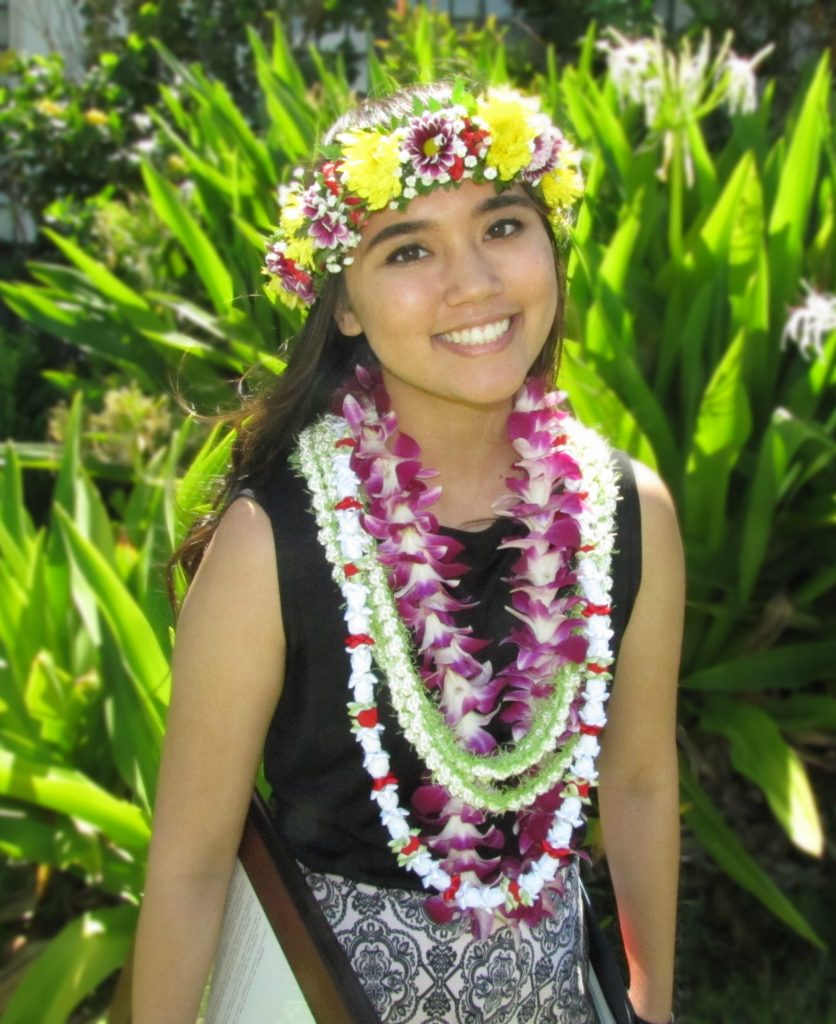
About the Author
Sydney Millerd was born and raised in Waipahu, Hawaiʻi, and is a senior at the University of Hawaiʻi-West Oʻahu where she is studying sustainable community food systems and political science. Over the past few months, she has worked with faculty advisor Dr. Esther Widiasih to analyze water quality at Mokauea loko iʻa (fishpond) and to learn about the rich history and culture of Mokauea Island. In addition to her schooling and research, she has served as the student body president of UHWO this past school year. Furthermore, with the knowledge and insights gained from her education and extracurricular experiences, she hopes to go into a sustainable initiative work to help preserve and protect the environment, culture, and humanity.
